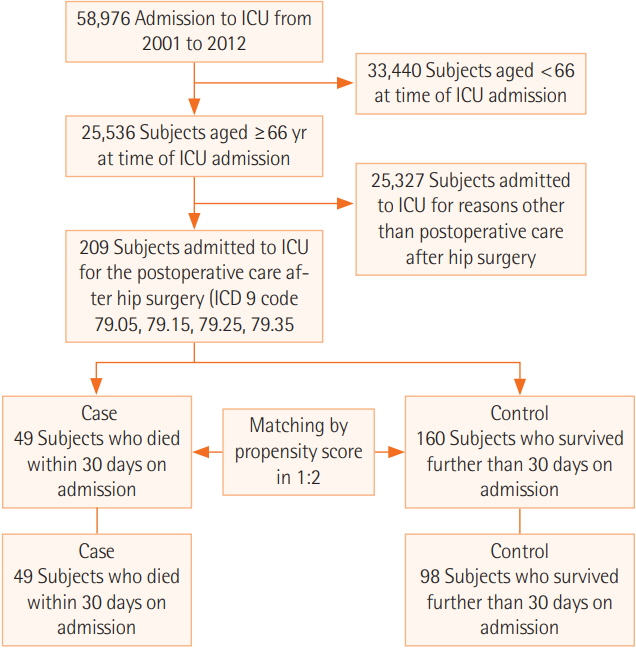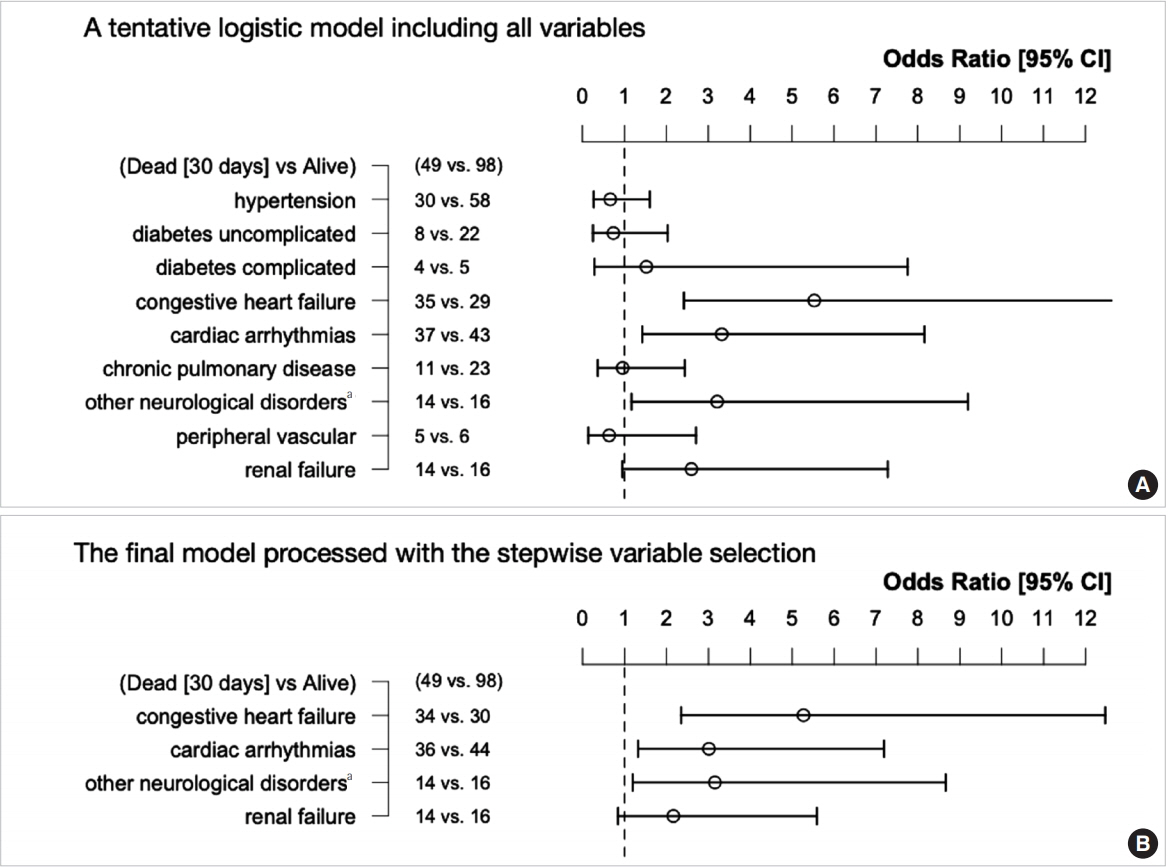Acute Crit Care.
2020 Feb;35(1):10-15. 10.4266/acc.2019.00745.
Elixhauser comorbidity measures-based risk factors associated with 30-day mortality in elderly population after femur fracture surgery: a propensity scorematched retrospective case-control study
- Affiliations
-
- 1Department of Anesthesiology and Pain Medicine, Dongguk University Ilsan Hospital, Goyang, Korea
- KMID: 2500945
- DOI: http://doi.org/10.4266/acc.2019.00745
Abstract
- Background
As the average life expectancy increases, anesthesiologists confront unique challenges in the perioperative care of elderly patients who have significant comorbidities. In this study, we evaluated Elixhauser comorbidity measures-based risk factors associated with 30day mortality in patients aged 66 years and older who underwent femur fracture surgery. Methods: We used the Medical Information Mart for Intensive Care III which contains the medical records of patients admitted to the intensive care unit (ICU) at Beth Israel Deaconess Medical Center in the United States between 2001 and 2012 to identify patients admitted to the ICU after femur fracture surgery (n=209). Patients who died within 30 days of admission (case group, n=49) were propensity score-matched to patients who did not (control group, n=98). The variables for matching were age, sex, race, anemia (hemoglobin ≤10 g/dl), and malignancy. We attempted to explain mortality via nine independent factors: hypertension, uncomplicated diabetes, complicated diabetes, congestive heart failure (CHF), cardiac arrhythmias, chronic pulmonary disease, renal failure, neurological disorders other than paralysis, and peripheral vascular disease. Results: Logistic regression identified three significant risk factors: CHF, arrhythmias, and neurological disorders other than paralysis. The odds ratio (OR) for the 30-day mortality of CHF was 4.99 (95% confidence interval [CI], 2.18 to 12.06). The equivalent ORs for cardiac arrhythmias and neurological disorders other than paralysis were 2.61 (95% CI, 1.14 to 6.21) and 2.40 (95% CI, 0.95 to 6.48), respectively. Conclusions: Identifying patients with these risk factors (CHF, arrhythmias, and neurological disorders other than paralysis) will assist clinicians with perioperative planning and provide caregivers with valuable information for decision-making.
Keyword
Figure
Reference
-
1. Association of Anaesthetists of Great Britain and Ireland, Griffiths R, Alper J, Beckingsale A, Goldhill D, Heyburn G, et al. Management of proximal femoral fractures 2011: Association of Anaesthetists of Great Britain and Ireland. Anaesthesia. 2012; 67:85–98.2. Lee DK, Bang S, Lee S. Anesthetic considerations for surgical treatment of geriatric femur fracture. Anesth Pain Med. 2019; 14:8–18.3. Charlson M, Szatrowski TP, Peterson J, Gold J. Validation of a combined comorbidity index. J Clin Epidemiol. 1994; 47:1245–51.
Article4. Moppett IK, Parker M, Griffiths R, Bowers T, White SM, Moran CG. Nottingham Hip Fracture Score: longitudinal and multiassessment. Br J Anaesth. 2012; 109:546–50.5. Nijmeijer WS, Folbert EC, Vermeer M, Slaets JP, Hegeman JH. Prediction of early mortality fol-lowing hip fracture surgery in frail elderly: the Almelo Hip Fracture Score (AHFS). Injury. 2016; 47:2138–43.
Article6. Dodd AC, Bulka C, Jahangir A, Mir HR, Obremskey WT, Sethi MK. Predictors of 30-day mortality following hip/pelvis fractures. Orthop Traumatol Surg Res. 2016; 102:707–10.
Article7. Kim BH, Lee S, Yoo B, Lee WY, Lim Y, Kim MC, et al. Risk factors associated with outcomes of hip fracture surgery in elderly patients. Korean J Anesthesiol. 2015; 68:561–7.
Article8. Johnson AE, Pollard TJ, Shen L, Lehman LW, Feng M, Ghassemi M, et al. MIMIC-III, a freely ac-cessible critical care database. Sci Data. 2016; 3:160035.
Article9. Maxwell MJ, Moran CG, Moppett IK. Development and validation of a preoperative scoring sys-tem to predict 30 day mortality in patients undergoing hip fracture surgery. Br J Anaesth. 2008; 101:511–7.
Article10. Elixhauser A, Steiner C, Harris DR, Coffey RM. Comorbidity measures for use with administra-tive data. Med Care. 1998; 36:8–27.
Article11. Wiles MD, Moran CG, Sahota O, Moppett IK. Nottingham Hip Fracture Score as a predictor of one year mortality in patients undergoing surgical repair of fractured neck of femur. Br J Anaesth. 2011; 106:501–4.
Article12. Charlson ME, Pompei P, Ales KL, MacKenzie CR. A new method of classifying prognostic comor-bidity in longitudinal studies: development and validation. J Chronic Dis. 1987; 40:373–83.
Article13. Rozzini R, Frisoni GB, Ferrucci L, Barbisoni P, Sabatini T, Ranieri P, et al. Geriatric Index of Comorbidity: validation and comparison with other measures of comorbidity. Age Ageing. 2002; 31:277–85.
Article14. Marufu TC, White SM, Griffiths R, Moonesinghe SR, Moppett IK. Prediction of 30-day mortality after hip fracture surgery by the Nottingham Hip Fracture Score and the Surgical Outcome Risk Tool. Anaesthesia. 2016; 71:515–21.
Article15. Menendez ME, Neuhaus V, van Dijk CN, Ring D. The Elixhauser comorbidity method outper-forms the Charlson index in predicting inpatient death after orthopaedic surgery. Clin Orthop Relat Res. 2014; 472:2878–86.
Article
- Full Text Links
- Actions
-
Cited
- CITED
-
- Close
- Share
- Similar articles
-
- A Comprehensive Analysis of the Causes and Predictors of 30-Day Mortality Following Hip Fracture Surgery
- Postoperative Mortality and the Associated Factors in Elderly Patients with Hip Fracture
- Distal Femur Fractures Treated with Distal Femoral Locking Plate Fixation: A Retrospective Study of One Year Mortality and Risk Factors
- C2 Fractures in the Elderly: Single-Center Evaluation of Risk Factors for Mortality
- A Comparative Study on Comorbidity Measurements with Lookback Period using Health Insurance Database: Focused on Patients Who Underwent Percutaneous Coronary Intervention



